Extremes Events of Tropical Island Thunderstorms
Does a Resolution Increase Improve their Representaion?
Martin Bergemann Uni Melbourne
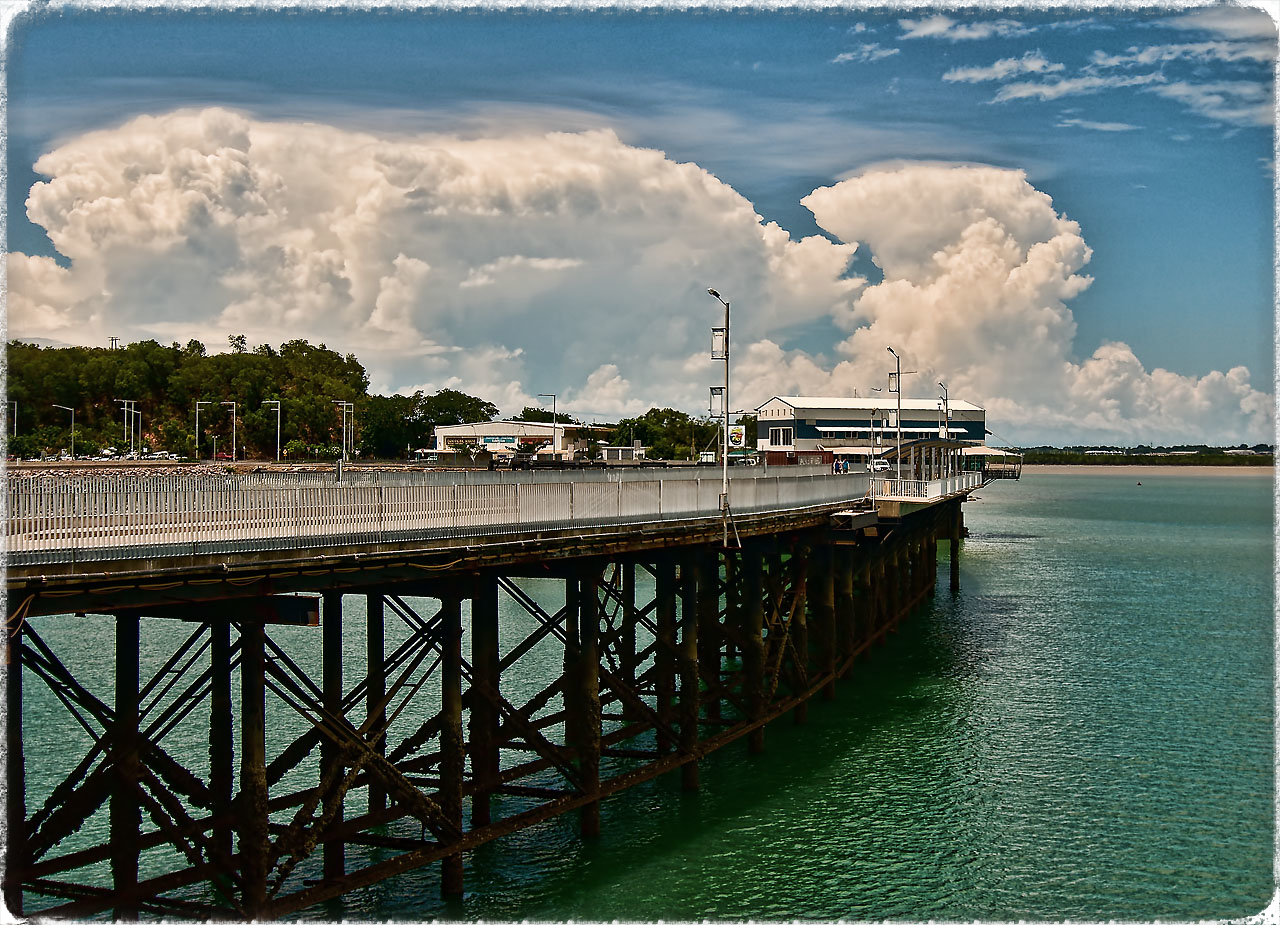
1.0 Introduction¶
Convective storms in coastal areas of the tropics are of extraordinary importance for the earth climate system by distributing heat and moisture in the tropical atmosphere (CITE). The geography of the Maritime Continent with more than X islands, plays pivotal role in driving the tropical Walker Circulation. In a recent study bla et al. showed that island thunderstorms, often influenced by meso-scale land-sea interactions, release more heat into the atmosphere than any other tropical region.
In [ ]:
Simulation of Hector Events (12/11 - 20/11/2006)¶
In [5]:
import folium
borders = (([-17.091, -7.443] , [122.963, 139.055]),
([-14.505, -10.005], [127.385, 134.693]),
([-13.757, -10.757], [129.557, 132.529]))
coordinates = []
for n, (lats, lons) in enumerate(borders):
x, y =[lons[0], lons[0], lons[1],lons[1]], [lats[0], lats[1], lats[1], lats[0]]
l = list(zip(x,y))
l.append(l[0])
coordinates.append(l)
geoJsonData = {
"features": [
{
"geometry": {
"coordinates": coordinates[0]
,
"type": "LineString"
},
"properties": {
"stroke": "#fc1717",
"stroke-opacity": 1,
"stroke-width": 2
},
"type": "Feature"
},
{
"geometry": {
"coordinates": coordinates[1]
,
"type": "LineString"
},
"properties": {
"stroke": "#1f1a95",
"stroke-opacity": 1,
"stroke-width": 2
},
"type": "Feature"
},
{
"geometry": {
"coordinates": coordinates[2]
,
"type": "LineString"
},
"properties": {
"stroke": "orange",
"stroke-opacity": 1,
"stroke-width": 2
},
"type": "Feature"
}
],
"type": "FeatureCollection"
}
loc=(131.043101, -12.250323)[::-1]
m = folium.Map(location=loc, zoom_start=6)
folium.Marker(loc, popup=None, tooltip='CPOL', icon=None).add_to(m)
#folium.GeoJson(geoJsonData,
# style_function=lambda x: {
# 'color' : x['properties']['stroke'],
# 'weight' : x['properties']['stroke-width'],
# 'opacity': 0.6,
# }).add_to(m)
display(m)
- Model Setup
In [6]:
m = folium.Map(location=loc, zoom_start=6)
folium.Marker(loc, popup=None, tooltip='CPOL', icon=None).add_to(m)
folium.GeoJson(geoJsonData,
style_function=lambda x: {
'color' : x['properties']['stroke'],
'weight' : x['properties']['stroke-width'],
'opacity': 0.6,
}).add_to(m)
display(m)
In [7]:
%%HTML
<ul>
<li>
<p><font color="#fc1717">4 km</font> → <font color='#1f1a95'>1.33 km</font>→ <font color='orange'> 0.44 km</font>
</li>
<li>80 Vertical Level</li>
<li>8 Ensemble Member, each 6 hours different init time</li>
</p>
</ul>
-
4 km → 1.33 km→ 0.44 km
- 80 Vertical Level
- 8 Ensemble Member, each 6 hours different init time
In [9]:
display(p3plot)
In [25]:
%%HTML
<figure>
<video width="750" height="400" loop="true" controls>
<source src='WeekOfHector-Ens-3.mp4' type="video/mp4">
</video>
<figcaption style="text-align: right">Example UM 0.44km Simulation and CPOL</figcaption>
</figure>
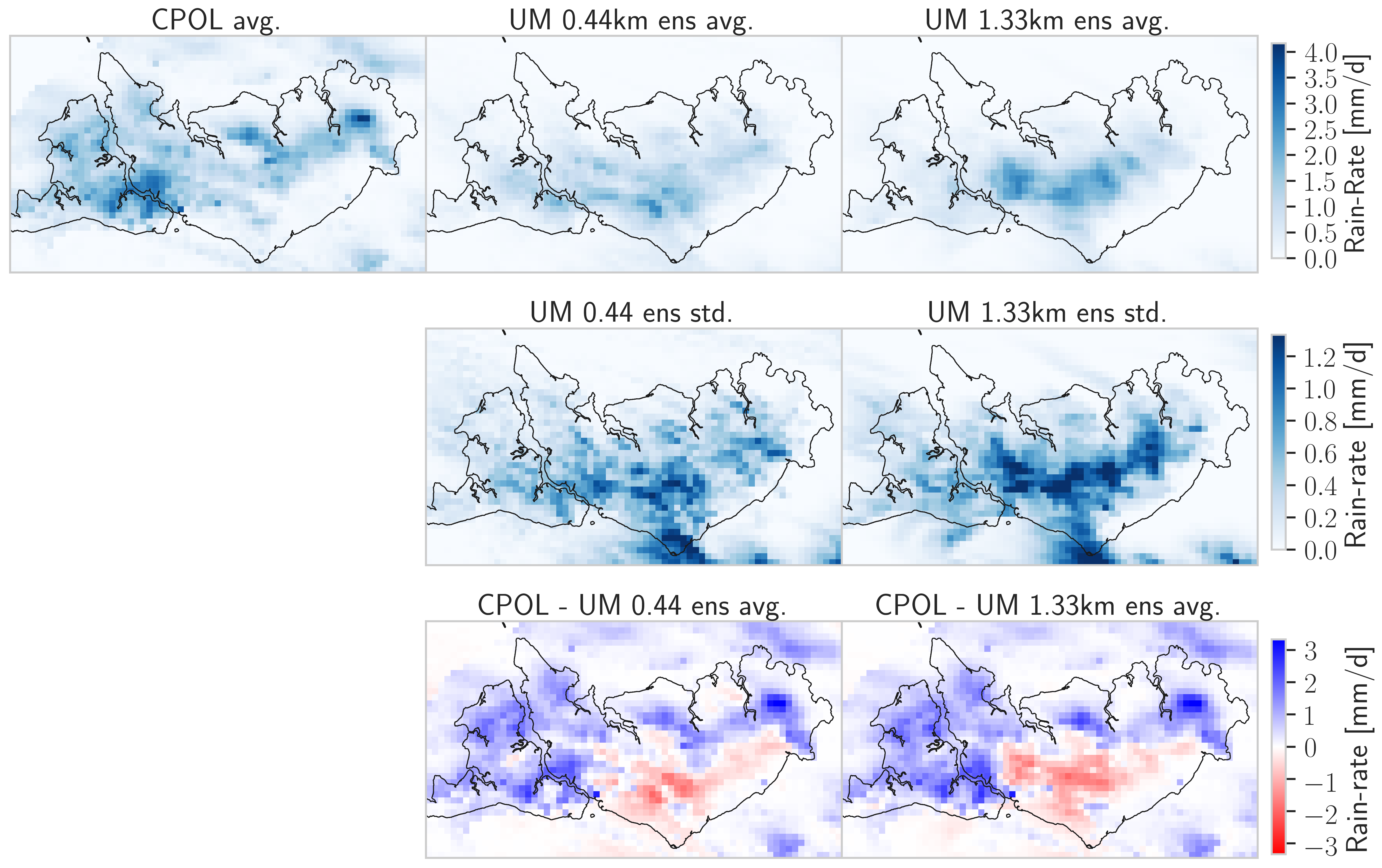
The simulated Diurnal Cycle¶
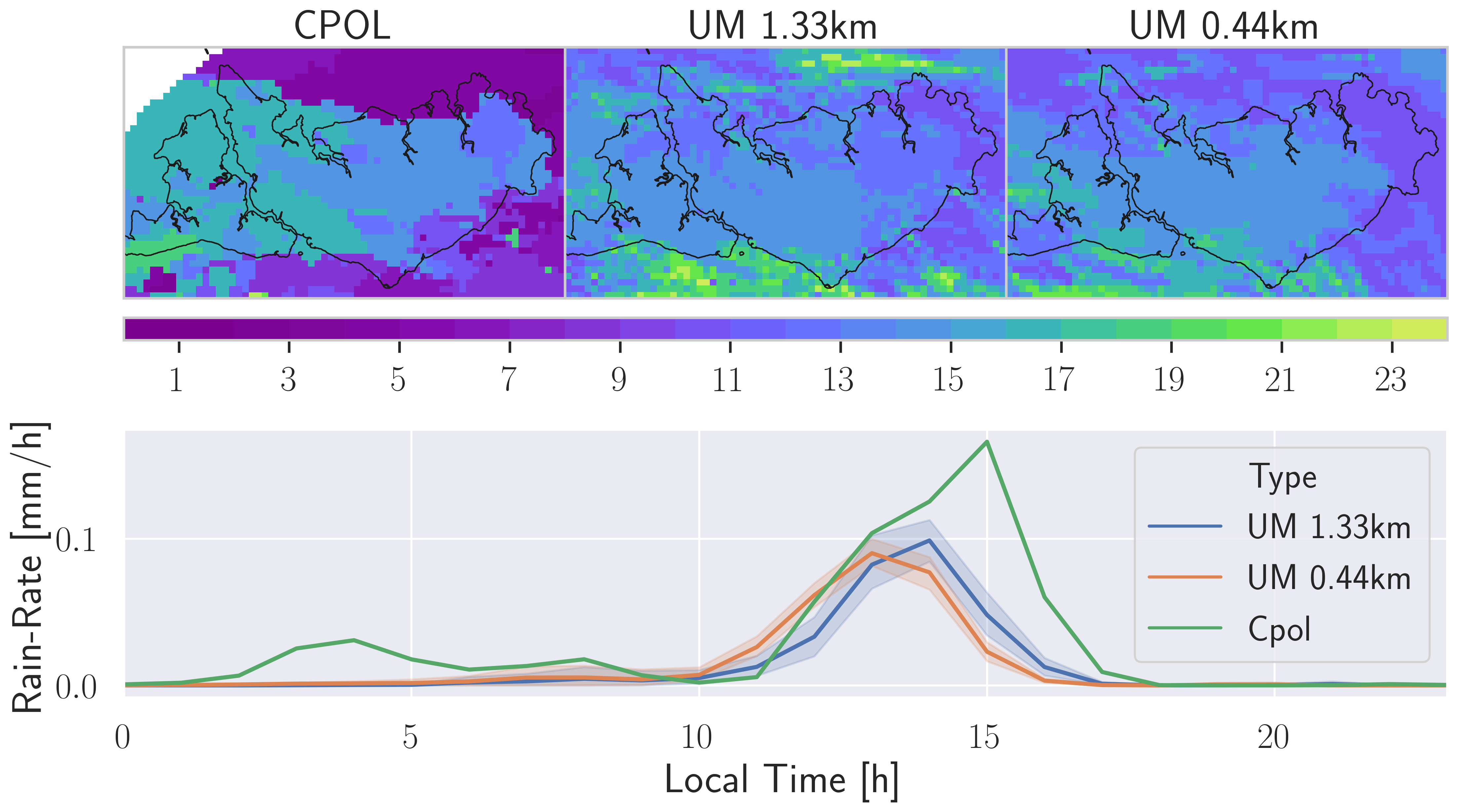
In [26]:
%%HTML
<figure>
<video width="750" height="400" loop="true" controls>
<source src='WeekOfHector-Diurnal-2.mp4' type="video/mp4">
</video>
<figcaption style="text-align: right">Diurnal Cycle</figcaption>
</figure>
How well are Extremes Represented?¶

In Summary:¶
- Storms are a Little too early in the Model
- Occure too Central over Melville Island
- Extreme Events are Slighly Over Estimated
- Slight Improvement with Higher Resolution Version
Storm-Track Analysis¶
- Analyse Strom tracks using an adopted tracking verion of TINT (TINT is not TITAN)
- TINT -> Tracking with Phase-Correlation and "Hungarian" similarity mathiching
In [15]:
display(pd.read_pickle('medians.pkl').round(2))
| UM 1.33km | UM 0.44km | CPOL | |
|---|---|---|---|
| Area | 76.67 | 61.25 | 110.68 |
| Duration | 60.00 | 50.00 | 60.00 |
| Avg-Rain | 4.78 | 5.65 | 4.52 |
| Max-Rain | 6.90 | 8.56 | 6.79 |
| Speed | 10.03 | 12.71 | 12.67 |
| # Storms | 73.00 | 50.00 | 42.00 |
Storm Intensities¶
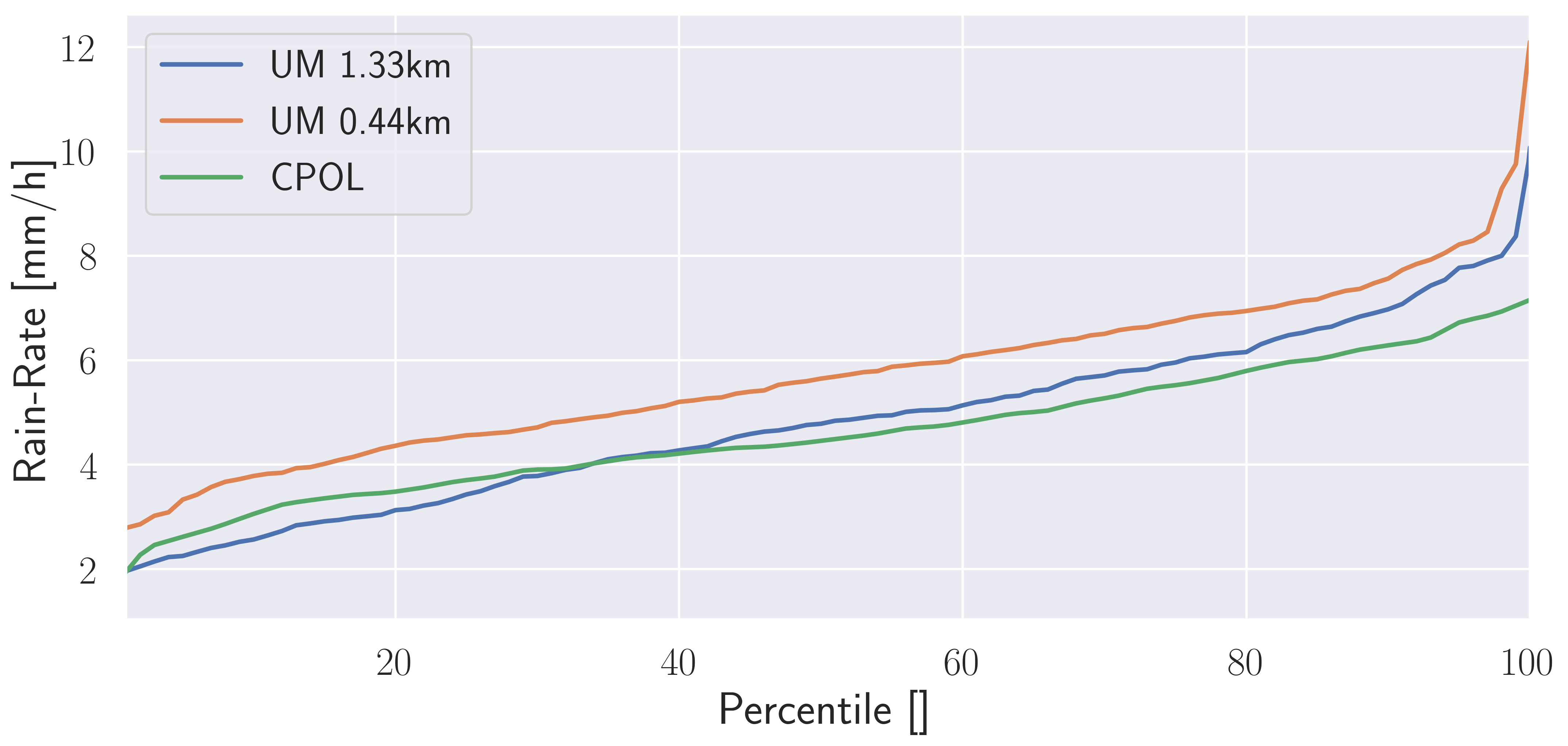
The strongest Stormes (>9th decile)¶
In [12]:
f = open('../slides/d3plot_map.dmp','rb')
mapplot = pickle.load(f)
f.close()
display(mapplot)
Storm Properties by Intensity¶
In [15]:
data1, data2 = [], []
obs = ('UM 1.33km', 'UM 0.44km', 'CPOL')
colors = ('#1f77b4', '#ff7f0e', 'green')
for ii in range(3):
df = cycles.loc[cycles.type == obs[ii]].sort_values('time')
#domain = [ii*1/3, ii*1/3+.3]
for i in range(0,6):
if i == 0:
tmp = df
visible = True
else:
tmp = df.loc[df.quant == i]
visible = False
tmp = tmp.groupby('time').mean()
y1 = tmp['rr']
y2 = tmp['dur']
x1 = tmp.index
trace = go.Scatter(
x = x1,
y = y1,
name=obs[ii],
xaxis='x',
yaxis='y',
mode = 'markers',
visible = visible
)
data1.append(trace)
trace = go.Scatter(
x = x1,
y = y2,
name=obs[ii],
xaxis='x',
yaxis='y2',
mode = 'lines',
showlegend = False,
line = dict(color = colors[ii], width = 2),
visible = visible
)
data2.append(trace)
y_axis_layout=dict( gridcolor='rgb(255,255,255)', showgrid=True, showline=False, showticklabels=True,
tickcolor='rgb(127,127,127)', ticks='outside', zeroline=False, title='Rain-Rate [mm/h]',
range=[2,10])
y_axis_layout2=dict( gridcolor='rgb(255,255,255)', showgrid=True, showline=False, showticklabels=True,
tickcolor='rgb(127,127,127)', ticks='outside', zeroline=False, title='Duration [min]',
range=[0,140], overlaying='y', side='right')
x_axis_layout=dict( gridcolor='rgb(255,255,255)', showgrid=True, showline=False, showticklabels=True,
tickcolor='rgb(127,127,127)', ticks='outside', zeroline=False, title='Life-Cycle [%]')
layout = go.Layout(
width=700,
height=600,
autosize=False,
paper_bgcolor='rgb(255,255,255)',
plot_bgcolor='rgb(229,229,229)',
xaxis=x_axis_layout,
yaxis=y_axis_layout,
yaxis2=y_axis_layout2,
legend=dict(orientation="h"),
font=dict(family='serif', size=18, color='#7f7f7f')
)
steps=[]
labels={i: str(i) for i in range(1,6)}
labels[0] = 'All'
for n in range(6):
step = dict(
method = 'restyle',
args = ['visible', [False] * (len(data1)+len(data2))],
label=labels[n])
for ii in range(3):
step['args'][1][n+ii*6] = True # Toggle i'th trace to "visible"
step['args'][1][(n+ii*6)+len(data1)] = True # Toggle i'th trace to "visible"
steps.append(step)
sliders = [dict(
active = 0,
currentvalue = {"prefix": "Quintile: "},
pad = {"t": 75},
steps = steps,
font = dict(size=16)
)]
layout['sliders'] = sliders
fig = go.Figure(data=data1+data2, layout=layout)
display(py.iplot(fig, show_link=False))
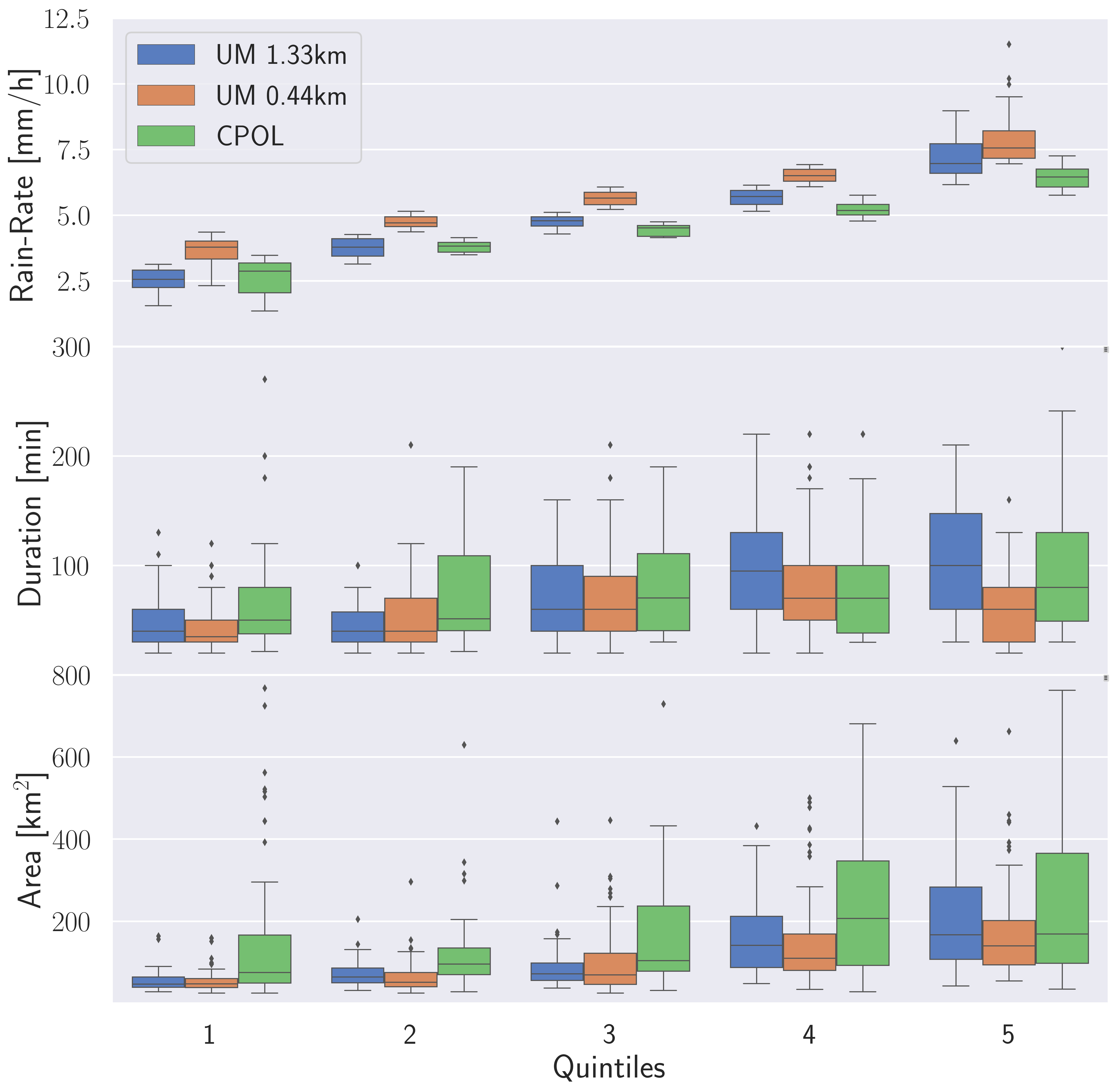
Why are Storms more intense in the Sub-km version?¶
- Investigation of Cold-Pools
In [16]:
%%HTML
<figure>
<video width="500" loop="true" controls>
<source src='/home/unimelb.edu.au/mbergemann/Work/notebooks/Work/Programming/Extremes/slides/ColdPool-Ens-1.mp4' type="video/mp4">
</video>
<figcaption style="text-align: right">Tracking with Density Potential Temperature Field Pertubation</figcaption>
</figure>

- The State of the Atmosphere
In [19]:
from copy import deepcopy
variables=dict(omega=(("$\\overline{\\omega'}$ [m/s]"), (-9.5e-2, 8.5e-1), 1),
mflux=("$\\overline{\\omega' q'}$ [m g/kg s]", (-1.2e-1, 1.6), 1000))#
nrow = 0
data = []
fontsize = 18
y_axis_layout=dict( gridcolor='rgb(255,255,255)', showgrid=True, showline=False, showticklabels=True,
titlefont=dict(size=fontsize), tickcolor='rgb(127,127,127)', ticks='outside',
zeroline=False, range=[P[0], P[-1]])
x_axis_layout=dict( gridcolor='rgb(255,255,255)', showgrid=True, showline=False, showticklabels=True,
tickcolor='rgb(127,127,127)', ticks='outside', zeroline=False, titlefont=dict(size=fontsize))
for layout_dict in (x_axis_layout, y_axis_layout):
layout_dict['tickfont']=dict(size=fontsize-2)
layout_dict['automargin'] = True
xaxis = {}
yaxis = {}
nplot = 1
nquint = 5
hspace, vspace = 0.01, 0.15
titles = []
colors = ('#1f77b4', '#ff7f0e')
for nvar, (var, prop) in enumerate(variables.items()):
nrow += 1
varn, xrange, mul = prop
for nn, quint in enumerate(range(1,nquint+1)):
for nrun, (run, flx) in enumerate(fluxes.items()):
x = flx[var][quint] * mul
if nrow == 1 :
yname = 'y'
else:
yname = 'y%i'%(nrow*nquint-nquint+1)
if nplot > 1:
showlegend=False
else:
showlegend=True
trace = go.Scatter(
x = x,
y = P,
name=run,
xaxis='x%i'%(nplot),
yaxis= yname,
visible = True,
showlegend = showlegend,
mode = 'lines',
line = dict(color = colors[nrun], width = 3)
)
data.append(trace)
yaxis['yaxis%i'%(nplot)] = deepcopy(y_axis_layout)
xaxis['xaxis%i'%(nplot)] = deepcopy(x_axis_layout)
xaxis['xaxis%i'%(nplot)]['title'] = varn
yaxis['yaxis%i'%(nplot)]['domain'] = split(len(variables), vspace)[nrow-1]
xaxis['xaxis%i'%(nplot)]['domain'] = split(nquint, hspace)[nn]
xaxis['xaxis%i'%(nplot)]['anchor'] = yname
yaxis['yaxis%i'%(nplot)]['anchor'] = 'x%i'%nplot
xaxis['xaxis%i'%(nplot)]['range'] = xrange
if quint == 1:
yaxis['yaxis%i'%(nplot)]['title']='Pressure [hPa]'
if nrow == 1:
xaxis['xaxis%i'%(nplot)]['range'] = xrange
sp = split(nquint, hspace)[nn]
titles.append(dict(x=(xrange[1]-xrange[0])/2 - ((xrange[1]-xrange[0])/20),
y=split(nquint, vspace)[-1][-1]+vspace/4,
showarrow=False,
text='Quintile %i'%quint,
xref='x%i'%(nplot),
yref='paper'))
nplot += 1
layout = go.Layout(
width=750,
height=800,
annotations=titles,
autosize=False,
paper_bgcolor='rgb(255,255,255)',
plot_bgcolor='rgb(229,229,229)',
font=dict(family='serif', size=fontsize, color='#7f7f7f')
)
for axis, axlayout in yaxis.items():
layout[axis] = axlayout
for axis, axlayout in xaxis.items():
layout[axis] = axlayout
'''
steps=[]
labels={i: str(i) for i in range(1,6)}
labels[0] = 'All'
for n in range(6):
step = dict(
method = 'restyle',
args = ['visible', [False] * len(data)],
label=labels[n])
for ii in range(2):
step['args'][1][n+ii*6] = True # Toggle i'th trace to "visible"
steps.append(step)
sliders = [dict(
active = 5,
currentvalue = {"prefix": "Quintile: "},
pad = {"t": 75},
steps = steps,
font=dict(size=16)
)]
layout['sliders'] = sliders
'''
fig = go.Figure(data=data, layout=layout)
display(py.iplot(fig, show_link=False))
- The State of the Atmosphere
In [20]:
from copy import deepcopy
from collections import OrderedDict
variables=dict(mse_pre=("$\overline{s_{v_{l}}'}/c_{p_{d}}$ [K]", (-1.4, 2), 1),
cloud_pl_rain=("$\overline{q_l'}$ [g/kg]", (-0.02, 0.3), 1))#
nrow = 0
data = OrderedDict()
fontsize = 18
y_axis_layout=dict( gridcolor='rgb(255,255,255)', showgrid=True, showline=False, showticklabels=True,
titlefont=dict(size=12), tickcolor='rgb(127,127,127)', ticks='outside',
zeroline=False, range=[P[0], P[-1]])
x_axis_layout=dict( gridcolor='rgb(255,255,255)', showgrid=True, showline=False, showticklabels=True,
tickcolor='rgb(127,127,127)', ticks='outside', zeroline=False,
titlefont=dict(size=fontsize-2))
for layout_dict in (x_axis_layout, y_axis_layout):
layout_dict['tickfont']=dict(size=fontsize-2)
layout_dict['automargin'] = True
xaxis = {}
yaxis = {}
nplot = 1
nquint = 5
hspace, vspace = 0.02, 0.15
titles = []
colors = ('#1f77b4', '#ff7f0e')
for nvar, (var, prop) in enumerate(variables.items()):
nrow += 1
varn, xrange, mul = prop
for nn, quint in enumerate(range(1,nquint+1)):
for nrun, (run, flx) in enumerate(fluxes.items()):
x = flx[var][quint] * mul
if nrow == 1 :
yname = 'y'
else:
yname = 'y%i'%(nrow*nquint-nquint+1)
if nplot > 1:
showlegend=False
name = 'during'
else:
showlegend=True
name = run
trace = go.Scatter(
x = x,
y = P,
name=name,
xaxis='x%i'%(nplot),
yaxis= yname,
visible = True,
showlegend = showlegend,
mode = 'lines',
line = dict(color = colors[nrun], width = 3)
)
data['%s_%s_%s'%(var, quint, run)] = trace
yaxis['yaxis%i'%(nplot)] = deepcopy(y_axis_layout)
xaxis['xaxis%i'%(nplot)] = deepcopy(x_axis_layout)
xaxis['xaxis%i'%(nplot)]['title'] = varn
yaxis['yaxis%i'%(nplot)]['domain'] = split(len(variables), vspace)[nrow-1]
xaxis['xaxis%i'%(nplot)]['domain'] = split(nquint, hspace)[nn]
xaxis['xaxis%i'%(nplot)]['anchor'] = yname
yaxis['yaxis%i'%(nplot)]['anchor'] = 'x%i'%nplot
xaxis['xaxis%i'%(nplot)]['range'] = xrange
if quint == 1:
yaxis['yaxis%i'%(nplot)]['title']='Pressure [hPa]'
if nrow == 1:
xaxis['xaxis%i'%(nplot)]['range'] = xrange
sp = split(nquint, hspace)[nn]
titles.append(dict(x=(abs(xrange[1]-xrange[0]))/2 - (abs(xrange[1]-xrange[0]))/3,
y=split(nquint, vspace)[-1][-1]+vspace/4,
showarrow=False,
text='Quintile %i'%quint,
xref='x%i'%(nplot),
yref='paper'))
nplot += 1
for quint in range(1, nquint+1):
for run in ('UM 1.33km', 'UM 0.44km'):
x = fluxes[run]['cloud_pl_pre'][quint]
key1 = 'cloud_pl_rain_%i_%s'%(quint, run)
key2 = 'cloud_pl_pre_%i_%s'%(quint, run)
new_data = deepcopy(data[key1])
new_data['visible']=False
new_data['x'] = x
new_data['name'] = 'before'
new_data['showlegend'] = False
data[key2] = new_data
for quint in range(1, nquint+1):
for run in ('UM 1.33km', 'UM 0.44km'):
x = fluxes[run]['cloud_pl_pre'][quint]
key1 = 'cloud_pl_rain_%i_%s'%(quint, run)
key2 = 'cloud_pl_prep_%i_%s'%(quint, run)
new_data = deepcopy(data[key1])
new_data['line']['dash'] = 'dash'
new_data['visible']=False
new_data['x'] = x
new_data['name'] = 'before'
new_data['showlegend'] = False
data[key2] = new_data
layout = go.Layout(
width=750,
height=800,
annotations=titles,
autosize=False,
paper_bgcolor='rgb(255,255,255)',
plot_bgcolor='rgb(229,229,229)',
font=dict(family='serif', size=fontsize, color='#7f7f7f')
)
for axis, axlayout in yaxis.items():
layout[axis] = axlayout
for axis, axlayout in xaxis.items():
layout[axis] = axlayout
steps=[]
Labels = ('Druing', 'Before', 'Before+During')
for n in range(3):
step = dict(
method = 'restyle',
args = ['visible', [True] * len(data)],# 'showlegend', [False] * len(data)],
label=Labels[n])
step['args'][-1][:2]=[True, True]
if n == 1:
step['args'][1][10:20] = 10*[False] # Toggle i'th trace to "visible"
#step['args'][1][-10:] = 10*[False] # Toggle i'th trace to "visible"
elif n == 0:
step['args'][1][-20:] = 20*[False] # Toggle i'th trace to "visible"
elif n == 2:
step['args'][1][-20:-10] = 10*[False] # Toggle i'th trace to "visible"
#step['args'][-1][3] = [True]
#step['args'][-1][-1] = [True]
steps.append(step)
sliders = [dict(
active = 0,
currentvalue = {"prefix": "State: "},
pad = {"t": 50},
steps = steps,
font=dict(size=fontsize)
)]
layout['sliders'] = sliders
fig = go.Figure(data=list(data.values()), layout=layout)
display(py.iplot(fig, show_link=False))
- Also somthing in the Boundary Layer
In [22]:
from scipy.stats import norm
from scipy.stats import gaussian_kde
from sklearn.neighbors import KernelDensity
data = []
var = 'ustar'
Min, Max = 0, 1
X_plot = np.linspace(Min, Max, 1000)
obs = ('UM 1.33km', 'UM 0.44km')
for ii in range(2):
df = pbl_types.loc[pbl_types.run == obs[ii]]
for i in range(0,6):
if i == 0:
tmp = df
else:
tmp = df.loc[df.quant == i]
visible = False
if i == 5:
visible = True
x = tmp[var].values[:]#.reshape(1,-1)
#kde = KernelDensity(kernel='gaussian', bandwidth=0.75).fit(x)
kde = gaussian_kde(x)
log_dens = kde(X_plot)
trace = go.Scatter(
x = X_plot,
y = log_dens,
name=obs[ii],
xaxis='x',
yaxis='y',
visible = visible,
mode='lines',
fill='tozeroy'
)
data.append(trace)
y_axis_layout=dict( gridcolor='rgb(255,255,255)', showgrid=True, showline=False, showticklabels=True,
tickcolor='rgb(127,127,127)', ticks='outside', zeroline=False, title='Density [%]',
range=[0, 3.7])
x_axis_layout=dict( gridcolor='rgb(255,255,255)', showgrid=True, showline=False, showticklabels=True,
tickcolor='rgb(127,127,127)', ticks='outside', zeroline=False, title='u* [m/s]')
layout = go.Layout(
width=700,
height=600,
autosize=False,
paper_bgcolor='rgb(255,255,255)',
plot_bgcolor='rgb(229,229,229)',
xaxis=x_axis_layout,
yaxis=y_axis_layout,
font=dict(family='serif', size=18, color='#7f7f7f')
)
steps=[]
labels={i: str(i) for i in range(1,6)}
labels[0] = 'All'
for n in range(6):
step = dict(
method = 'restyle',
args = ['visible', [False] * len(data)],
label=labels[n])
for ii in range(2):
step['args'][1][n+ii*6] = True # Toggle i'th trace to "visible"
steps.append(step)
sliders = [dict(
active = 5,
currentvalue = {"prefix": "Quintile: "},
pad = {"t": 75},
steps = steps,
font=dict(size=16)
)]
layout['sliders'] = sliders
fig = go.Figure(data=data, layout=layout)
display(py.iplot(fig, show_link=False))
In [24]:
%%HTML
<figure>
<video width="750" height="350" loop="true" controls>
<source src='/home/unimelb.edu.au/mbergemann/Work/notebooks/Work/Programming/Extremes/slides/ColdPool_nativ_2.mp4' type="video/mp4">
</video>
<figcaption style="text-align: right">Cold-Pool (center) and Rainfall (outer) for two ensemble member</figcaption>
</figure>
<img src="/home/unimelb.edu.au/mbergemann/Work/notebooks/Work/Programming/Extremes/slides/Diagram1.png" alt="Study area" style="height:150px;"/>
<p>One possible problem: Micro-Phys. depends on RH<sub>crit</sub> that is chosen on 80!! levels</p>

One possible problem: Micro-Phys. depends on RHcrit that is chosen on 80!! levels
In [ ]: